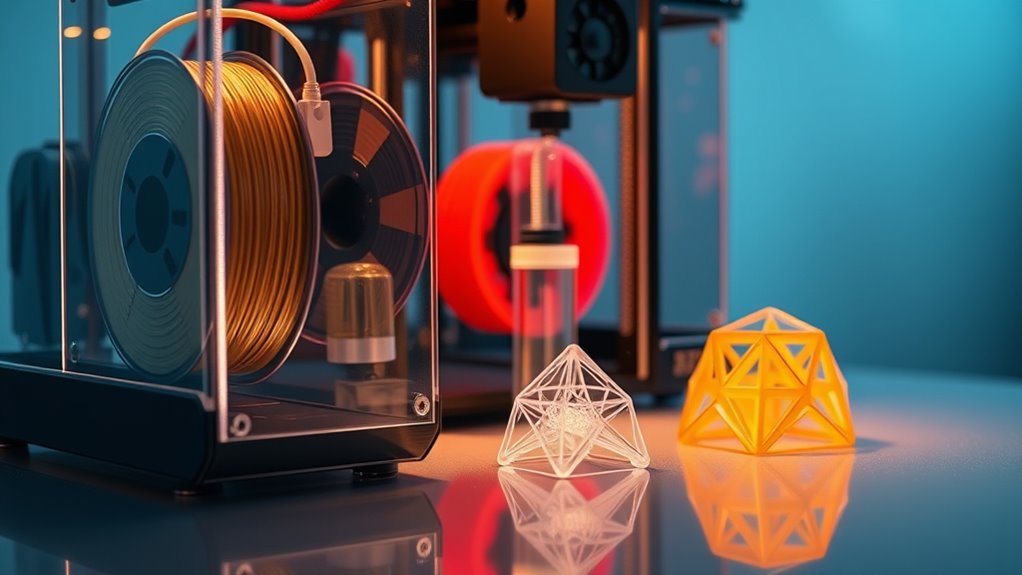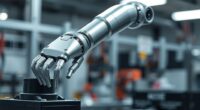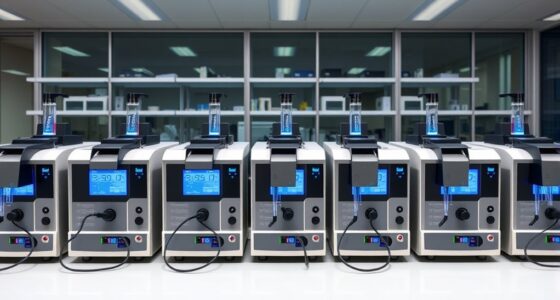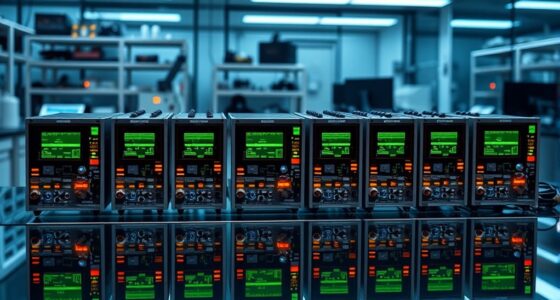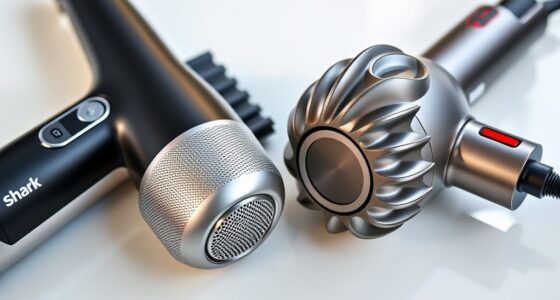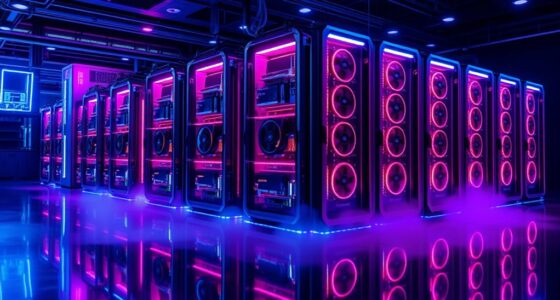If you’re looking for the 14 best multi-material 3D printers of 2025 for precision and versatility, I recommend options like the Creality Hi(A) Combo, Kobra S1 Combo, and FLASHFORGE AD5X, which offer multi-color, multi-material capabilities with fast speeds and large build volumes. These printers support advanced features like automatic calibration, multi-material switching, and high temperatures for complex filaments. Keep exploring, and you’ll discover which model fits your project needs perfectly.
Key Takeaways
- Top models offer multi-material and multi-color capabilities, supporting complex, multi-step prints with high precision.
- Advanced automatic calibration and filament detection ensure reliable, high-quality multi-material printing.
- High-speed printing up to 600mm/s and large build volumes enable versatile, professional-grade multi-material projects.
- Enclosed designs with safety and noise reduction features enhance usability for diverse applications.
- Compatibility with a wide range of filaments, including flexible and composite materials, expands creative and functional possibilities.
ELEGOO Neptune 4 Plus 3D Printer
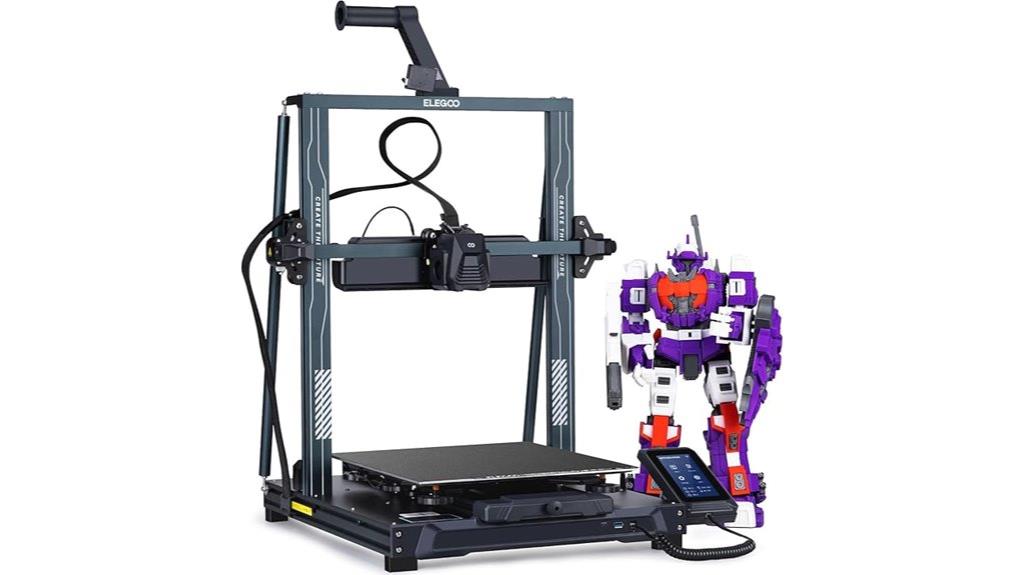
If you’re looking for a versatile 3D printer that combines speed, large build volume, and reliable multi-material capabilities, the ELEGOO Neptune 4 Plus is an excellent choice. It reaches speeds up to 500mm/s supported by Klipper firmware, with accelerations up to 12,000mm/s² for rapid, high-quality prints. Its spacious build volume of 320x320x385mm allows for bigger models or multiple objects. Equipped with automatic calibration features like input shaping and pressure advancing, it guarantees precise details. The self-developed dual-gear direct drive extruder supports various filaments up to 300°C, making it perfect for complex, multi-material projects.
Best For: hobbyists, educators, and small-scale professionals seeking a high-speed, large-volume 3D printer with reliable multi-material capabilities.
Pros:
- Supports speeds up to 500mm/s with high acceleration for fast, detailed printing
- Large build volume of 320x320x385mm ideal for bigger models or multiple objects
- Equipped with advanced automatic calibration features like input shaping and pressure advancing for precise results
Cons:
- Setup instructions are not fully detailed, requiring users to research beforehand
- Some software issues such as failed print resumes and WiFi connectivity problems
- Requires regular maintenance like nozzle replacement and bed leveling for optimal performance
Longer LK5 Pro 3D Printer with Large Printing Size
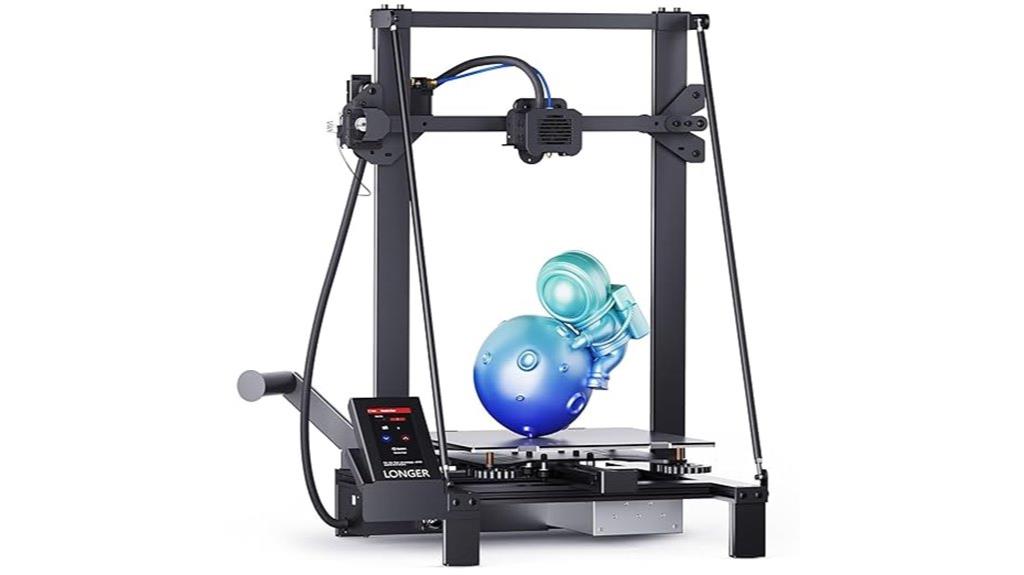
The Longer LK5 Pro 3D Printer stands out for those who need a large build volume combined with precise, high-speed printing. Its reinforced triangular frame minimizes vibrations, guaranteeing stability during long, detailed jobs. With an expansive printing area of 11.8 x 11.8 x 15.7 inches, it handles big projects easily. Automatic X and Y calibration boost accuracy to 0.1mm, while a silicon carbide glass platform ensures strong adhesion. Capable of printing at 180mm/s, it balances speed with quality. Features like auto-resume, filament detection, and open-source firmware make it user-friendly and customizable, ideal for both hobbyists and professionals.
Best For: hobbyists, educators, and professionals seeking a large-volume 3D printer with high precision and fast speeds for complex projects.
Pros:
- Large build volume (11.8 x 11.8 x 15.7 inches) accommodates big and detailed models
- High printing speed of 180mm/s ensures efficient and rapid production
- Automatic calibration and user-friendly features like filament detection and auto-resume simplify operation
Cons:
- As a delta-style frame, assembly may be more complex for complete beginners
- Larger size might require more space and stable setup environment
- Open-source firmware allows customization but may require technical knowledge for advanced modifications
FLASHFORGE AD5X Multi-Color 3D Printer
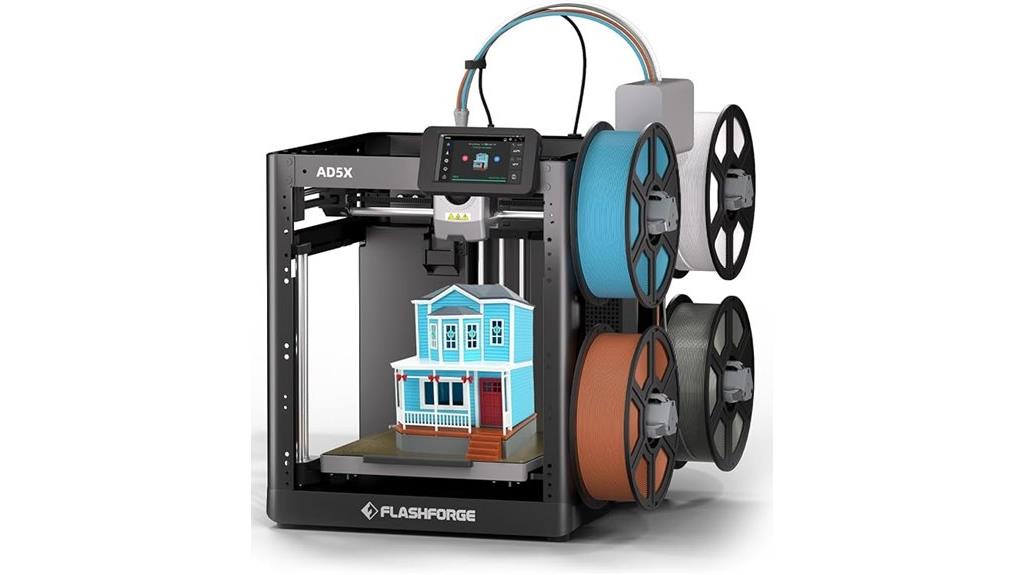
Designed for hobbyists and educators seeking vibrant, multi-color prints, the FLASHFORGE AD5X stands out with its advanced multi-color printing technology that can handle up to four colors simultaneously. I appreciate its Intelligent Filament System, which automatically manages filament and reduces downtime. Its high-speed performance—up to 600mm/s—ensures quick, detailed results, while the sturdy all-metal Core XY structure provides stability for precise prints. The enclosed design enhances safety and material handling, making it beginner-friendly. Supporting flexible TPU and a large build volume, the AD5X balances versatility with ease of use, making it ideal for creative projects and rapid prototyping.
Best For: hobbyists and educators seeking vibrant, multi-color 3D prints with quick turnaround times and user-friendly operation.
Pros:
- Supports up to four colors simultaneously for intricate, multi-color designs
- High-speed printing capability of up to 600mm/s for rapid project completion
- Enclosed design and intuitive touchscreen make it safe and easy to operate, ideal for beginners
Cons:
- Limited build volume of 150x150x150mm may require rafts for larger models, increasing waste
- Nozzles are proprietary, which could limit options and increase replacement costs
- External filament spools may be necessary for larger or more convenient filament management
Original Prusa XL Assembled 3D Printer with 5 Toolheads
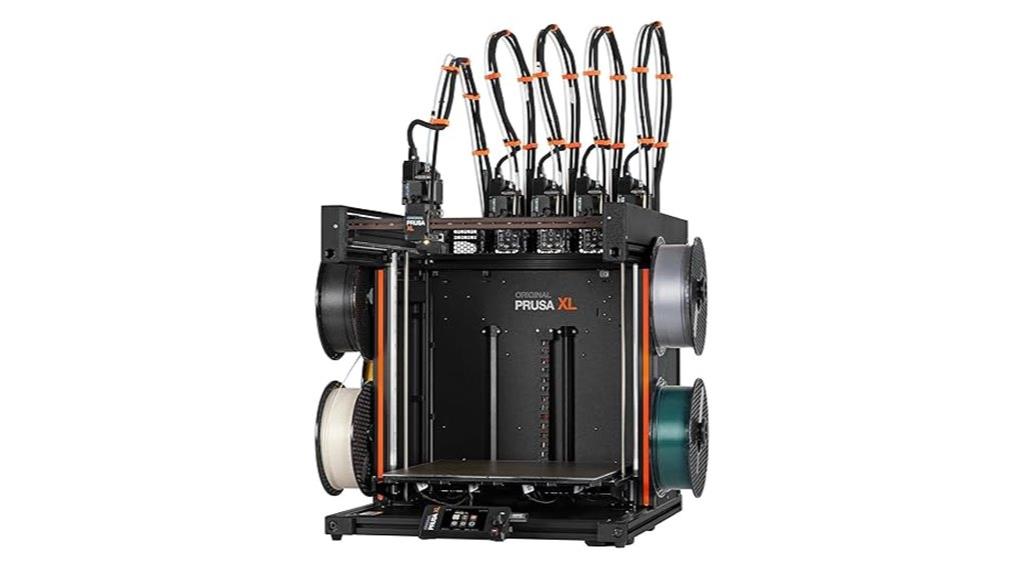
For professionals and serious hobbyists needing large-scale, multi-material prints, the Original Prusa XL Assembled 3D Printer with 5 Toolheads stands out as an ideal choice. It offers a massive 14.17-inch cube build volume, perfect for big projects. With five independent toolheads, it supports multi-material, multi-color, and complex printing, greatly reducing production time. The CoreXY motion system and segmented heatbed ensure high precision and edge-to-edge quality. Designed for versatility, it’s easy to set up, with quick toolhead swapping and optional enclosure support. Plus, Prusa’s lifetime tech support and extensive features make it a reliable, powerful choice for demanding applications.
Best For: professionals and serious hobbyists requiring large-scale, multi-material, multi-color, and complex 3D printing projects with high precision and reliability.
Pros:
- Massive 14.17-inch cube build volume ideal for large projects
- Five independent toolheads enable multi-material and multi-color printing to reduce production time
- Fully assembled, tested, and supported with lifetime technical assistance for reliable operation
Cons:
- Large size may require significant space and setup area
- Higher cost compared to smaller or simpler 3D printers
- Some fragile parts are packed separately, requiring careful assembly and handling
FLASHFORGE Adventurer 5M 3D Printer
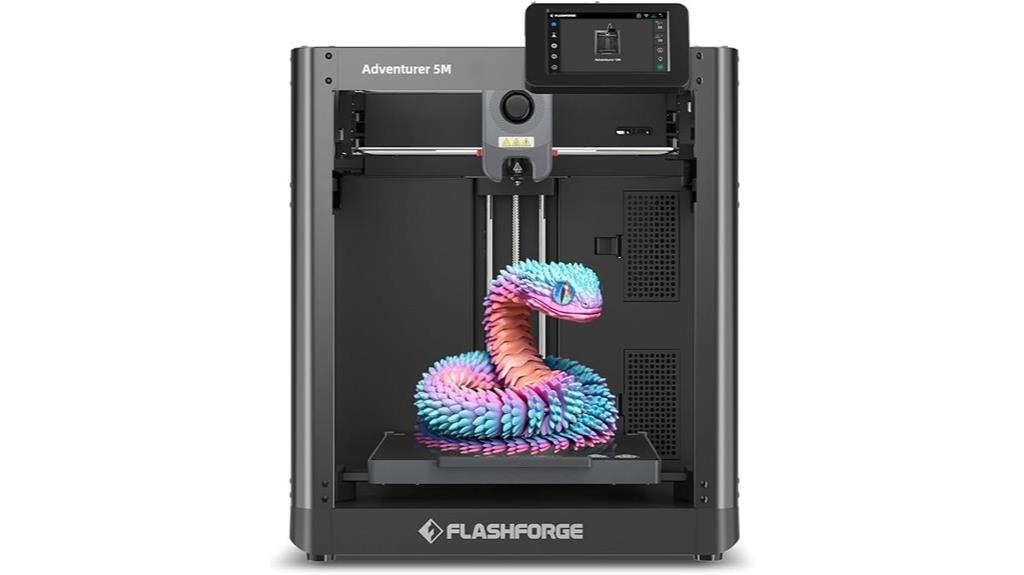
If you’re looking for a high-speed, reliable 3D printer that’s perfect for hobbyists and educational settings, the FlashForge Adventurer 5M stands out. It’s an enclosed, all-metal CoreXY with a 220x220x220mm build volume and fully automatic bed leveling, making setup quick and simple. Its direct extruder reaches 280°C, supporting high-flow nozzles for fast, detailed prints. The magnetic, self-leveling heated bed and vibration compensation guarantee consistent quality. With speeds up to 600mm/s and easy filament loading, it’s ideal for rapid prototyping and creative projects. The gantry supports upgrades like enclosures and cameras, adding versatility for various applications.
Best For: hobbyists, educators, and small-scale creators seeking a reliable, easy-to-use high-speed 3D printer for rapid prototyping and creative projects.
Pros:
- Fast printing speeds up to 600mm/s with stable high-quality output
- Fully automatic bed leveling and magnetic heated bed for easy setup and maintenance
- Compact, enclosed all-metal CoreXY design with upgrade options like enclosures and cameras
Cons:
- Limited build volume of 220x220x220mm may not suit larger projects
- Included slicer software (FlashPrint) is basic; users may prefer switching to more advanced options
- Some users report filament feeding issues and spool holder design could be improved
Creality K1 SE 3D Printer
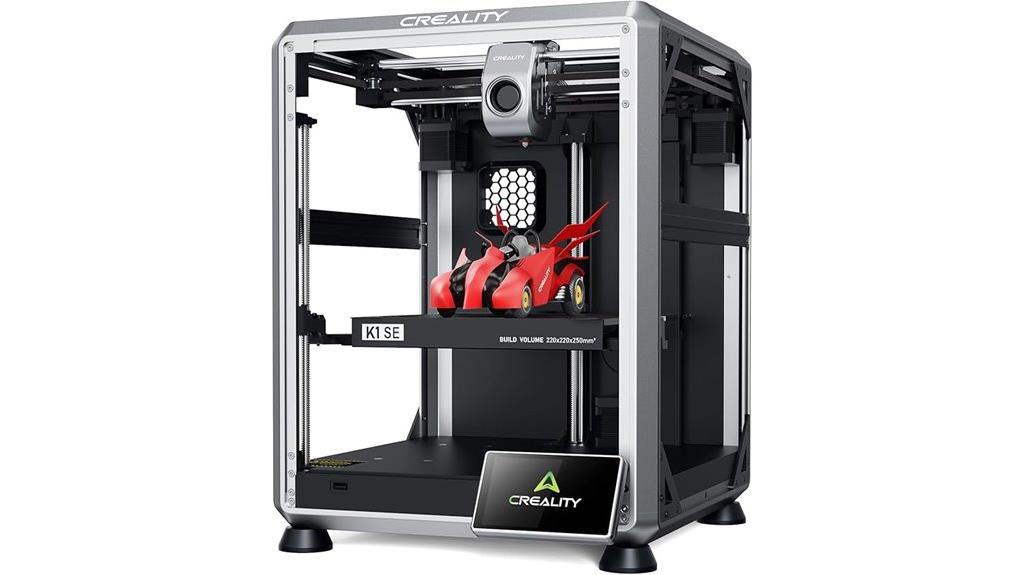
The Creality K1 SE 3D Printer stands out for its lightning-fast speed, making it ideal for users who need rapid, high-quality multi-material prints. Its lightweight CoreXY system reaches speeds up to 600mm/s with acceleration of 20,000mm/s², maintaining excellent print quality at these velocities. Equipped with a reliable extruder and tri-metal nozzle, it handles flexible filaments and heats up to 300℃ in just 75 seconds. The rigid aluminum frame ensures stability during high-speed printing, while auto-calibration and active cooling improve surface finish. Running on open-source Creality OS, it’s a versatile, powerful choice for precision multi-material printing in 2025.
Best For: makers and professionals seeking ultra-fast, high-quality multi-material 3D printing with reliable precision and stability.
Pros:
- Exceptional printing speeds up to 600mm/s combined with high acceleration for rapid production
- Durable aluminum frame and stable CoreXY system ensure consistent results during high-speed operation
- Open-source Creality OS offers advanced features like linear advance and input shaping for enhanced print quality
Cons:
- Heavier weight (22.5 pounds) may require sturdy setup space and handling considerations
- Complex components like tri-metal nozzles may involve more maintenance and part replacement
- Higher cost compared to standard 3D printers, potentially limiting entry-level users
Creality Hi(A) Combo 3D Printer
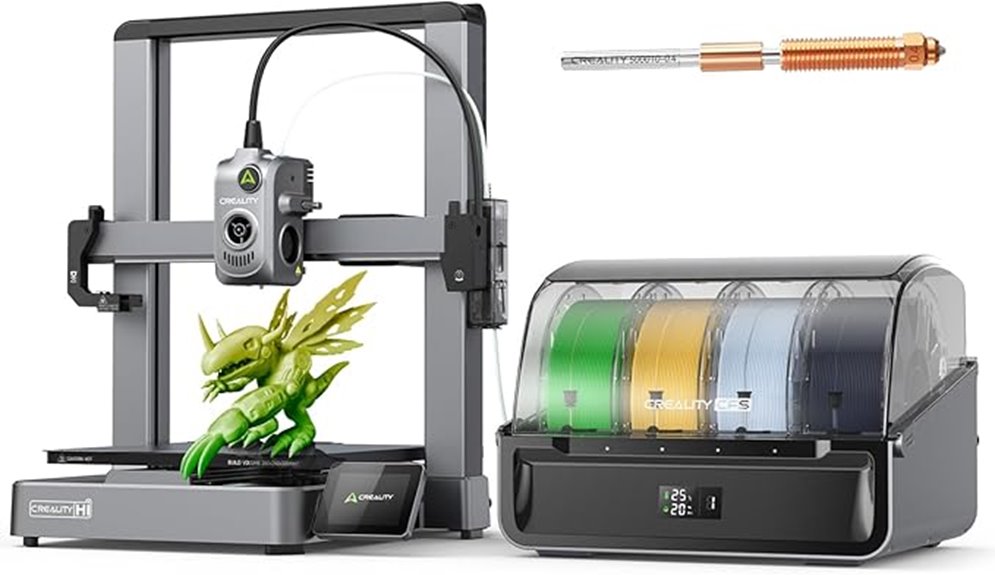
The Creality Hi(A) Combo 3D Printer stands out for its impressive multi-material and multi-color capabilities, making it an ideal choice for professionals and advanced hobbyists seeking vibrant, detailed prints. Its large 260x260x300mm build volume, all-metal frame, and industrial-grade motion system ensure stability and precision. Supporting 16-color multi-material printing via four CFS units, it handles a variety of materials like PLA, PETG, ABS, and PLA-CF. Features such as RFID filament detection, automated calibration, and seamless connectivity streamline the printing process. With a user-friendly 3.2-inch touchscreen and quick setup, it’s designed to deliver versatile, high-quality results effortlessly.
Best For: Professionals and advanced hobbyists seeking vibrant, multi-material, and high-precision 3D printing with versatile material options and automated features.
Pros:
- Supports 16-color multi-material printing with vibrant gradient effects and soluble supports.
- Large 260x260x300mm build volume with all-metal frame and industrial-grade motion system for stability and precision.
- User-friendly features including automated bed leveling, RFID filament detection, and a 3.2-inch foldable touchscreen for easy operation.
Cons:
- The printer’s size and weight may require a dedicated space and sturdy surface for setup.
- Advanced features and multi-material capabilities may come with a higher initial cost.
- Requires familiarity with multi-material printing and calibration for optimal results.
Anycubic Kobra S1 3D Printer (Sealed Storage, Multi-Color, High-Speed, High-Precision)
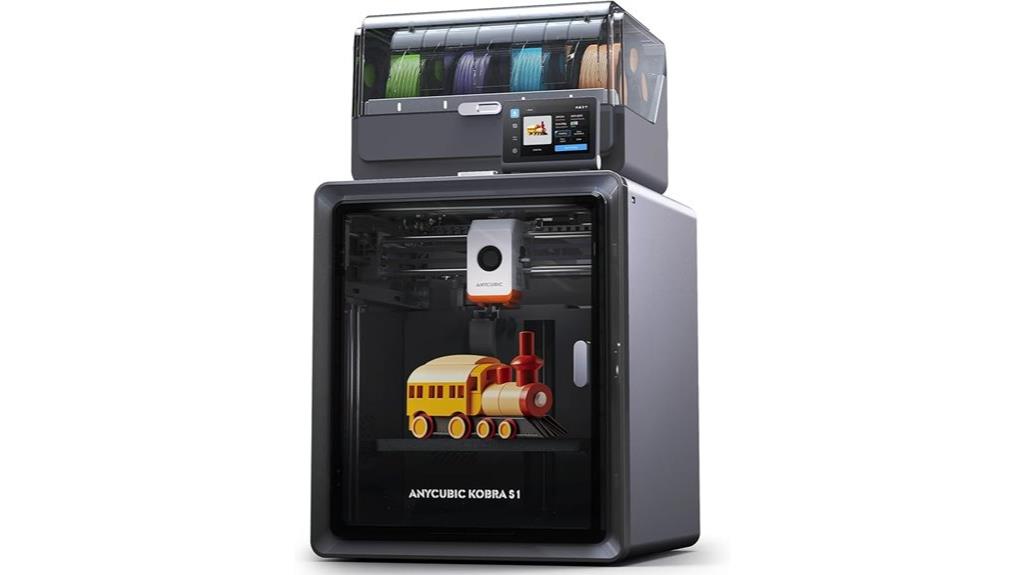
For creators demanding high-speed, multi-color 3D printing with precise results, the Anycubic Kobra S1 stands out as a top choice. Its multi-color capabilities, supporting 4 or 8 colors with dual units, deliver vibrant, detailed prints. The compact design measures 20 x 20 x 25 inches and weighs just over 56 pounds, making it versatile for various setups. With a maximum speed of 600mm/s and advanced acceleration, it can produce complex models up to 12 times faster than standard printers. Features like sealed storage, efficient filament drying, and remote management via the Anycubic App guarantee consistent quality and convenience, making it ideal for multi-material projects.
Best For: creators and professionals seeking high-speed, multi-color 3D printing with precise, detailed results.
Pros:
- Supports multi-color printing with 4 or 8 colors for vibrant, detailed models
- Capable of printing at speeds up to 600mm/s, significantly reducing production time
- Features sealed storage and advanced filament drying technology for consistent quality
Cons:
- Relatively heavy and bulky at over 56 pounds, which may affect portability
- Customer ratings are moderate at 3.6 out of 5 stars, indicating mixed reviews on performance or reliability
- Advanced features like multi-color and high-speed printing may require more setup and calibration for optimal results
Bambu Lab AMS Lite Automatic Material System
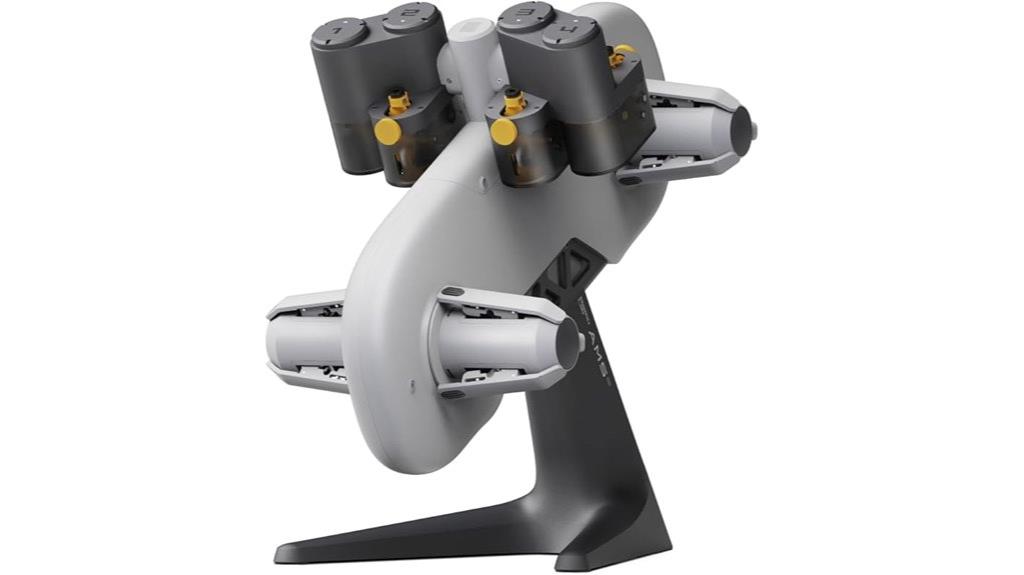
If you’re looking to streamline multi-color and multi-material printing, the Bambu Lab AMS Lite Automatic Material System stands out with its four filament slots and automatic filament switching. Designed for the Bambu Lab A1 Series, it supports vibrant, complex prints by handling up to four colors or materials simultaneously. Its RFID filament sync guarantees automatic identification, optimizing print settings and reducing errors. The system detects filament run-out and switches spools automatically, minimizing downtime. Plus, the translucent shell allows easy monitoring, and its simple design makes maintenance straightforward. Overall, it enhances efficiency, reduces waste, and simplifies multi-material printing, making it a valuable addition for precision-focused users.
Best For: users seeking to enhance multi-color and multi-material 3D printing with minimal effort and high precision, especially those using Bambu Lab A1 Series printers.
Pros:
- Supports up to four filament colors or materials simultaneously for vibrant, complex designs
- Automatic filament detection and switching reduce downtime and minimize errors
- Transparent shell design allows easy monitoring and straightforward maintenance
Cons:
- Compatible exclusively with Bambu Lab A1 Series 3D printers, limiting versatility
- Slightly larger dimensions may require additional space for setup
- Customer ratings are good but not perfect, indicating potential for improvements or user experience issues
Anycubic Kobra S1 Combo 3D Printer
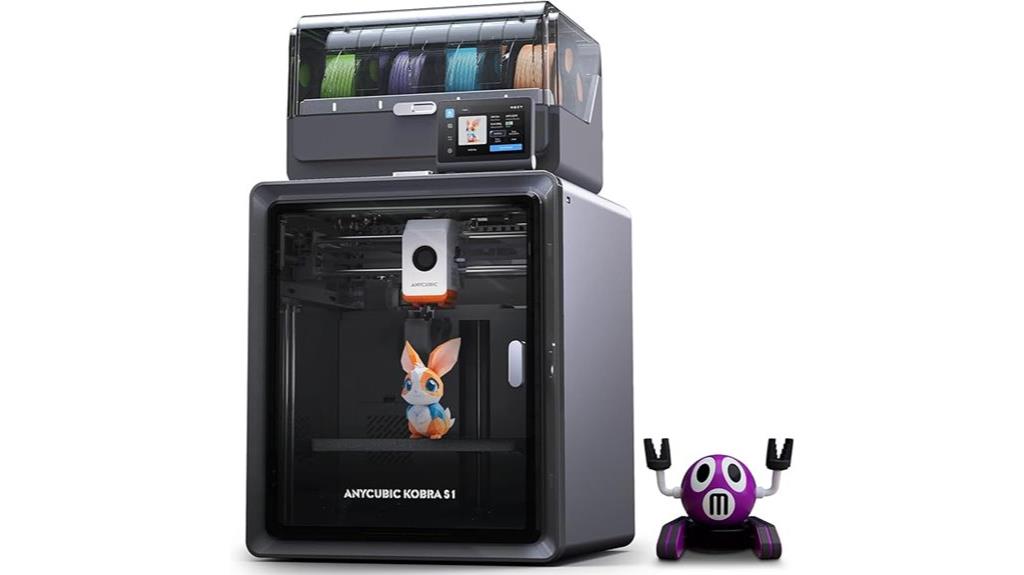
With support for up to 8-color multi-material printing, the Anycubic Kobra S1 Combo stands out as an ideal choice for those seeking high versatility and detailed multi-material models. Its fully enclosed coreXY design offers a 250×250×250mm build volume and ultra-fast speeds of 600mm/s. The full metal hotend handles materials like ABS and ASA at 320℃, while dual PTC heating and 360° hot air circulation guarantee filament quality. Features like automatic filament feeding, resonance compensation, and remote monitoring via app make printing efficient and precise. Quiet operation at 44dB and a robust ecosystem further elevate this machine’s usability for complex, multi-material projects.
Best For: hobbyists, educators, and professionals seeking high-speed, multi-material 3D printing with precise detail and versatile material compatibility.
Pros:
- Supports up to 8-color multi-material printing for complex, colorful models
- Ultra-fast printing speeds of 600mm/s combined with resonance and flow correction for high accuracy
- Fully enclosed coreXY design with remote monitoring and quiet operation at 44dB
Cons:
- The high-temperature hotend (up to 320℃) may require careful handling and maintenance
- Large build volume of 250×250×250mm might be limited for very large projects
- The complexity of multi-material setup could be challenging for beginners
FLASHFORGE Adventurer 5M 3D Printer with Auto Leveling

The FLASHFORGE Adventurer 5M stands out as an excellent choice for beginners and hobbyists seeking a reliable, high-speed 3D printer that simplifies the printing process. Its enclosed design, automatic bed leveling, and magnetic heated bed make setup and maintenance straightforward. With a direct extruder reaching 280°C, high-flow nozzle, and dual fans, it delivers high-quality prints quickly. The 12X print speed and vibration compensation ensure precision even at rapid speeds. User-friendly touchscreen, quick warm-up, and easy filament loading make it accessible. Overall, the Adventurer 5M offers stability, ease of use, and upgrade potential, making it ideal for prototyping and creative projects.
Best For: beginners, hobbyists, and educators seeking a reliable, high-speed 3D printer with minimal setup and maintenance.
Pros:
- Easy to set up and operate, ideal for beginners
- Fast printing speeds with high-quality results
- Automatic bed leveling and magnetic heated bed for simple maintenance
Cons:
- Limited build volume (220x220x220mm) may restrict larger projects
- Included slicer software (FlashPrint) is less versatile; better control with alternative slicers recommended
- Some users report filament feeding issues and nozzle clogging over time
FLASHFORGE AD5X 3D Printer with Auto Leveling and High-Speed Printing
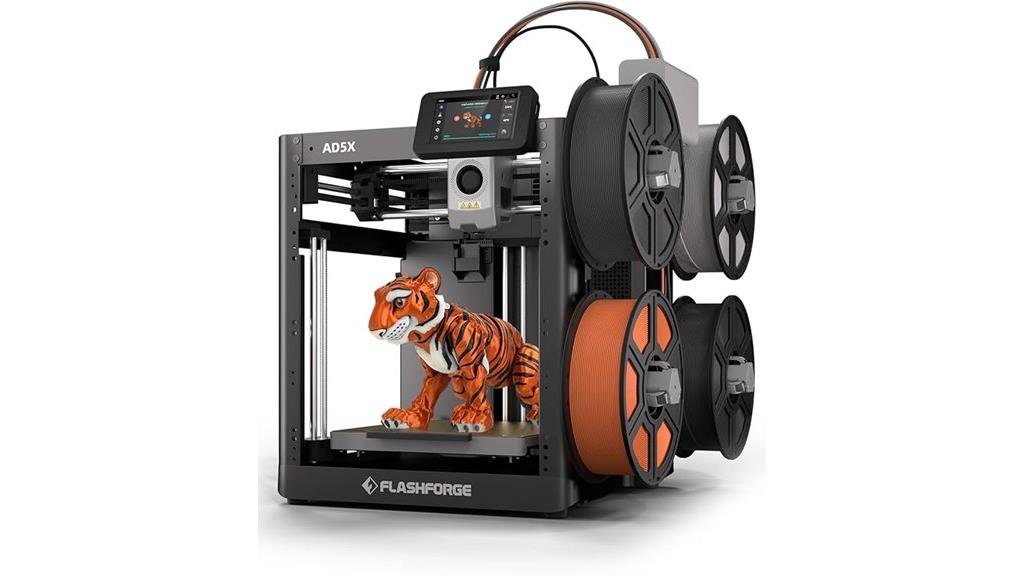
The FlashForge AD5X stands out for anyone needing rapid, multi-color 3D printing with minimal setup. Its CoreXY structure delivers speeds up to 600mm/s and high acceleration, making it perfect for quick prototypes and batch runs. Supporting up to four colors simultaneously, it’s great for detailed miniatures and vibrant projects. The 300°C direct-drive extruder and interchangeable nozzles ensure precision and versatility. Auto leveling simplifies calibration, while the enclosed design reduces noise and fumes. With a 220x220x220mm build volume, it balances size and capability, making it an excellent choice for users demanding speed, multi-material options, and ease of use.
Best For: hobbyists, educators, and professionals seeking fast, multi-color 3D printing with high precision and ease of setup.
Pros:
- High-speed printing up to 600mm/s with excellent acceleration for rapid prototyping.
- Supports multi-color printing with up to four different filaments simultaneously, ideal for detailed and vibrant models.
- User-friendly features like 1-Click Auto Leveling and built-in resume function simplify operation and reduce setup time.
Cons:
- Software stability issues on MacOS and limitations with support generation can hinder workflow.
- Proprietary .gx file format and limited filament spool size may require additional adjustments or re-spooling.
- Noisier fans and outdated Wi-Fi interface can be distracting and less convenient for continuous indoor use.
Creality Ender 5 Max 3D Printer
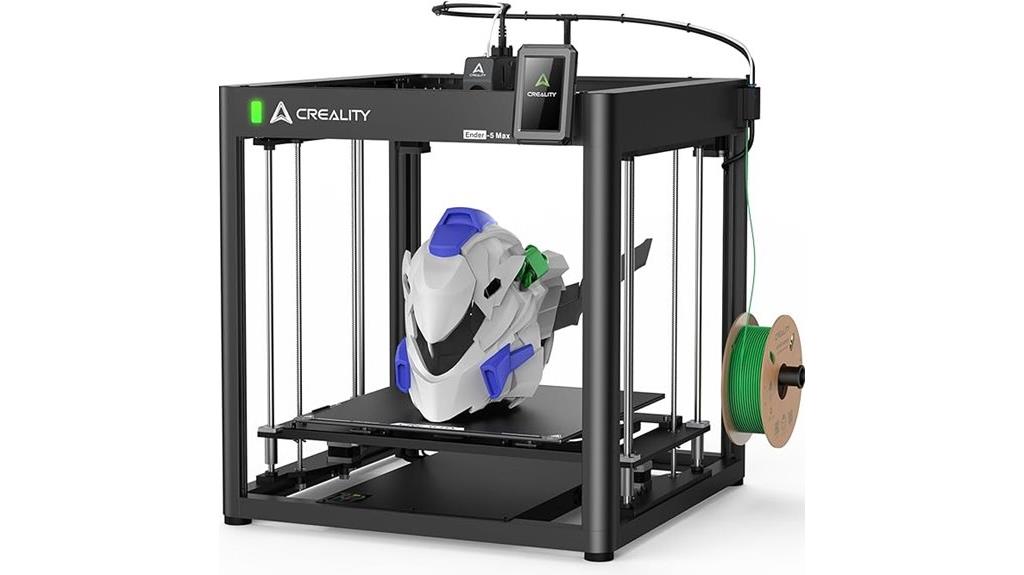
If you’re looking for a versatile 3D printer capable of handling large projects at high speeds, the Creality Ender 5 Max stands out. It features a high-torque XY motor that reaches speeds up to 700 mm/s with rapid acceleration, enabling quick production of models. Its reliable dual-gear direct drive extruder with hardened gears guarantees smooth extrusion and long-lasting performance, even in heated environments. The large 400×400×400mm build volume supports both small batch runs and big prototypes. Plus, its fast-heating 1000W bed reaches 80 °C in under 200 seconds, making it compatible with a wide range of materials.
Best For: makers and professionals seeking a large-volume 3D printer capable of high-speed, precise, and versatile printing for both small batches and large prototypes.
Pros:
- Exceptional printing speed up to 700 mm/s with rapid acceleration, ideal for quick production.
- Large 400×400×400mm build volume supports diverse project sizes and batch printing.
- Reliable all-metal dual gear extruder ensures smooth filament flow and durability in heated environments.
Cons:
- High power consumption due to the 1000W heating bed, which may increase operational costs.
- The large size and weight of the printer can make setup and relocation challenging.
- Advanced features and high-speed capabilities may require a steep learning curve for beginners.
FLASHFORGE AD5M Pro 3D Printer with High-Speed & Precision

Designed for users who value speed and precision, the FLASHFORGE AD5M Pro 3D Printer stands out with its high-speed capabilities and versatile multi-material support. Its fully enclosed, compact design guarantees safety and quiet operation, making it suitable for home, classroom, or creative environments. Setup is simple: just remove the bed bolts, connect the LCD, and start printing. With a 280℃ extruder, fast heating, and speeds up to 600mm/s, it delivers high-quality, detailed prints across various filaments like TPU, ABS, and PETG. The auto-leveling bed, intuitive touchscreen, and remote management via Flash Maker app make operation seamless and efficient.
Best For: hobbyists, educators, and small-scale professionals seeking high-speed, precise 3D printing with versatile filament support in a safe, quiet, and user-friendly enclosure.
Pros:
- High-speed printing capabilities up to 600mm/s with consistent quality
- Fully enclosed design reduces noise and enhances safety for indoor use
- Easy setup with automatic bed leveling and intuitive touchscreen interface
Cons:
- Some users report difficulties connecting the monitor cable due to non-standard socket
- Software compatibility issues, especially on newer macOS platforms, can complicate setup
- Fans and airflow turbulence may produce louder noise levels during operation
Factors to Consider When Choosing Multi‑Material 3D Printers
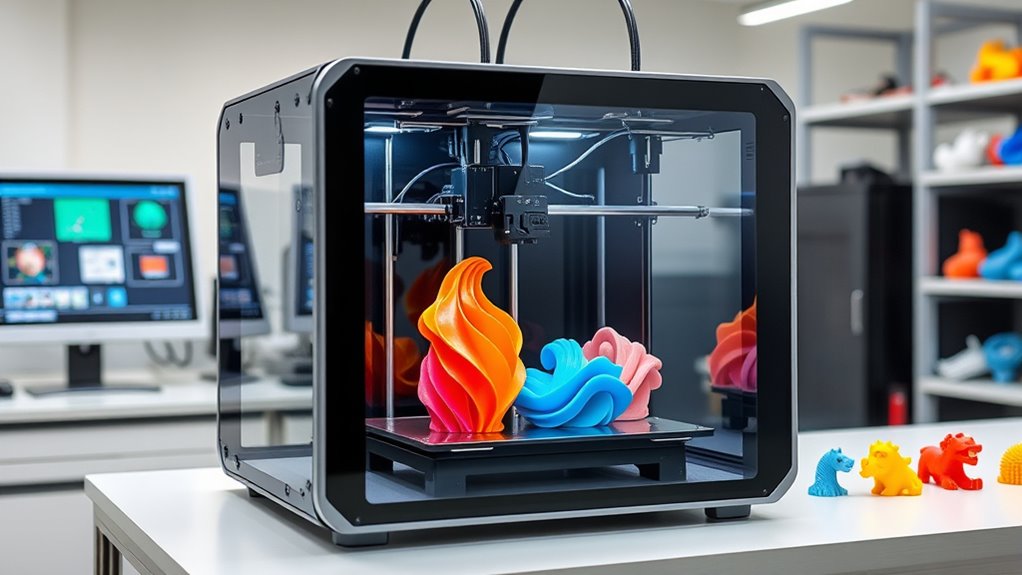
When selecting a multi-material 3D printer, I focus on factors like material compatibility and color options to match my project needs. Speed, calibration, and filament management also play vital roles in ensuring smooth operation and productivity. Considering these points helps me choose a machine that’s efficient, reliable, and easy to maintain.
Material Compatibility Range
Choosing a multi-material 3D printer requires careful attention to its material compatibility range, which determines the variety of filaments it can handle. Many printers support common filaments like PLA, ABS, PETG, TPU, nylon, and composites, offering versatility for complex projects. Compatibility mainly depends on the hotend temperature range, with most printers reaching at least 300°C to print high-performance materials like ABS and nylon. Some models feature dedicated multi-color or multi-material extrusion systems, allowing simultaneous printing with different filaments and colors. Filament diameter support, typically 1.75mm or 2.85mm, also influences compatibility. Additionally, filament management features like automatic switching or drying systems can expand the range of materials a printer can handle efficiently, broadening your creative possibilities.
Multi-Color Capabilities
Multi-color capabilities substantially enhance the versatility of multi-material 3D printers by allowing you to create vibrant, complex designs in a single print. These printers can extrude four or more filaments simultaneously, enabling seamless color transitions and detailed, multi-hued models. Advanced features like automatic filament switching, RFID detection, and multi-material support make multi-color printing more efficient and reliable. This reduces the need for post-processing or assembling separate parts, saving time and effort. Achieving consistent color accuracy depends on proper calibration and filament management, which are essential to avoid issues like color bleeding or cross-contamination. To maximize these capabilities, look for printers with specialized print heads or multiple extruders, ensuring smooth, precise multi-color printing for your creative projects.
Printing Speed and Efficiency
Speed and efficiency are vital factors to consider in multi-material 3D printers, especially when working on complex or large-scale projects. High printing speeds, like 600mm/s, allow for rapid production, markedly reducing overall project time. Efficient printers often include automatic filament switching and detection, minimizing manual intervention and downtime. Advanced motion systems, such as CoreXY, enable faster, more precise multi-material printing with minimal vibrations, enhancing print quality. Optimized flow management—like flow compensation and correction—ensures consistent extrusion even at high speeds. However, maintaining stability is essential; stable temperature control and effective cooling systems are necessary to preserve print quality across multiple materials. Balancing speed with reliability helps achieve efficient, high-quality multi-material prints.
Calibration and Ease
When selecting a multi-material 3D printer, ease of calibration plays a crucial role in ensuring consistent, high-quality prints. Automated features like auto bed leveling and toolhead calibration save time and reduce errors, making setup straightforward. User-friendly interfaces with clear instructions help me avoid frustration, especially when manually calibrating. Quick toolhead swapping and simple filament management minimize downtime and calibration adjustments between different materials. High-precision sensors and input shaping technology keep positioning accurate during complex multi-material prints, boosting reliability. Regular maintenance, such as nozzle cleaning and bed leveling checks, is essential for maintaining ease of calibration and ideal performance. Overall, a printer with these features makes multi-material printing more accessible and consistent, ensuring professional results with less effort.
Filament Management System
A well-designed filament management system is essential for smooth multi-material 3D printing, as it automates filament switching, detection, and storage to reduce manual effort. Advanced systems often feature RFID technology, enabling automatic filament identification and setting adjustments, which streamline complex print jobs. Proper filament handling minimizes waste, prevents tangling, and reduces issues like drying or contamination. Features such as automatic loading, run-out detection, and backup functions ensure continuous operation with minimal user intervention. Translucent or easily accessible filament compartments allow quick monitoring and easy replenishment, saving time and maintaining efficiency. When choosing a printer, prioritize a system that simplifies filament management, enhances reliability, and supports seamless multi-material printing—key factors for achieving precision and versatility in your projects.
Software and Interface
Choosing the right software and interface is key to maximizing your multi-material 3D printer’s capabilities. An intuitive interface with clear menus and controls makes setup and operation easier, reducing errors. Compatibility with popular slicing programs like Cura, Simplify3D, or dedicated software gives you greater control over complex multi-material processes, including precise color or material changes. Features such as auto filament switching, real-time monitoring, and remote management enhance efficiency and reduce waste. A good interface also provides visual previews, detailed status updates, and straightforward calibration options, helping ensure successful prints. Overall, selecting software that supports advanced multi-material functions minimizes mistakes and streamline your workflow, making your 3D printing experience more reliable and productive.
Build Volume Size
Have you considered how the size of a 3D printer’s build volume impacts your multi-material projects? A larger build volume lets you print bigger models or multiple smaller objects in one go, boosting productivity and creative options. Most multi-material printers offer build sizes from around 150×150×150mm up to over 400×400×400mm, depending on the model. Keep in mind, bigger volumes may require more precise calibration and temperature control to ensure consistent quality across the entire area. On the other hand, smaller build volumes are ideal for detailed miniatures or prototypes but can limit the size and complexity of your projects. When choosing, think about your typical project size and whether the printer’s capacity aligns with your multi-material needs.
Cost and Maintenance
Investing in a multi-material 3D printer means accepting higher upfront costs due to its complex hardware, multiple extruders, and color capabilities. These advanced features drive the initial price up compared to single-material models. Maintenance costs also tend to be higher, as frequent nozzle cleaning, replacements, and calibration are necessary to prevent cross-contamination and ensure quality. The system’s complexity can lead to more expensive repairs and troubleshooting, especially if specialized parts or firmware updates are needed. Regular upkeep, like cleaning filament paths and checking alignment, is essential to avoid costly hardware failures. Additionally, consumables such as multiple filament spools and support materials add ongoing expenses. Overall, while multi-material printers offer versatility, they require careful budgeting for both initial investment and maintenance.
Frequently Asked Questions
How Do Multi-Material Printers Handle Different Filament Types Simultaneously?
Multi-material printers handle different filament types simultaneously by using multiple extrusion heads, each dedicated to a specific filament. I find that these heads can switch between materials seamlessly, thanks to advanced hotend design and precise temperature controls. This setup allows me to print complex, multi-colored, or multi-functional objects without hassle. The printer’s software manages the coordination, ensuring each material is deposited accurately and at the right time.
What Maintenance Is Required for Multi-Material 3D Printers?
Maintaining multi-material 3D printers means meticulous monitoring, regular cleaning, and consistent calibration. I check nozzles for clogs, clear filament paths, and wipe away residue to prevent clogs and guarantee smooth operations. I also lubricate moving parts, update firmware, and replace worn-out components when needed. Proper maintenance keeps my printer precise, productive, and problem-free, ensuring I get the best prints every time without unexpected interruptions.
Can Multi-Material Printers Print With Flexible and Rigid Materials Together?
Yes, multi-material printers can print flexible and rigid materials together. I’ve used them to create complex, multi-textured parts by switching between different filaments during a single print. These printers are equipped with multiple extruders or advanced mixing capabilities, allowing seamless combination of diverse materials. This versatility lets me produce functional prototypes and intricate models that require both flexibility and rigidity in one print, saving time and enhancing creativity.
How Do Multi-Material Printers Ensure Color Accuracy Across Different Materials?
Imagine a painter blending colors seamlessly on a canvas—that’s how multi-material printers achieve color accuracy. They use advanced calibration, precise filament feed control, and real-time monitoring to guarantee consistent color across different materials. By fine-tuning temperature and extrusion parameters for each material, these printers make sure your final piece looks vibrant and cohesive, no matter how many different materials or shades are involved.
Are There Specific Software Requirements for Multi-Material 3D Printing?
Yes, there are specific software requirements for multi-material 3D printing. I recommend using slicing software that supports multi-material setups, like Ultimaker Cura or Simplify3D, which allow you to assign materials and control print parameters precisely. Additionally, firmware that manages material switching seamlessly is essential. These tools help guarantee accurate color and material transitions, making your multi-material prints more reliable and professional-looking.
Conclusion
Choosing the right multi-material 3D printer is like finding the perfect brush for a masterpiece—each one offers unique strokes of precision and versatility. Whether you need detailed prints or large-scale projects, these models are your palette. As you explore your options, remember that the right printer turns your ideas into vibrant, tangible realities. Embrace the art of multi-material printing—your creative journey awaits, ready to unfold like a colorful tapestry of innovation.
